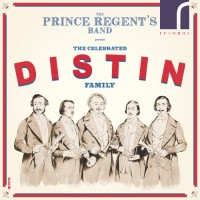 The Prince Regent’s Band, The Celebrated Distin Family. Resonus Records, 2016.
The Prince Regent’s Band, The Celebrated Distin Family. Resonus Records, 2016.
Richard Fomison; soprano cornet in Eb, cornet in Bb, contralto saxhorn in Bb, Richard Thomas; soprano cornet in Eb cornet in Bb, contralto saxhorn in Bb, tenor saxhorn in Eb, Anneke Scott: tenor saxhorn in Eb, ventil horn in Eb, Phil Dale; baritone saxhorn in Bb, Jeff Miller; contrabass saxhorn in Eb.www.princeregentsband.com
Those who were lucky enough to hear The Prince Regent’s Band recital at the 2017 HBS Symposium in New York can attest to their wonderful skill and musicality. This world-class ensemble comprised of 5 leading early brass specialists offers a program on this CD that vividly presents the cultural contributions of an important musical family as well as explores the sound-world of the rapidly changing brass ensemble from the period between the French Revolution of 1785 and the end of the First World War in 1918. This CD consists of 19 brass arrangements drawn from operas, dances, folk songs, and patriotic tunes of the day as well as orchestral repertoire.
As Anneke Scott explains in the informative CD booklet, no known sources of the actual repertoire survives. This recorded program consists of representative pieces documented in surviving advertising and reviews of Distin concerts. Works are included that were known to be in their repertoire and which represent the genres they frequently performed such as the "Coronation March" from Meyerbeer’s opera Le Prophete, the traditional Irish song "The Last Rose of Summer," James Kent’s coronation anthem Blessed be Thou, O God, and Handel’s "Let the Bright Seraphim." Some other works include Arban’s arrangement of selections from Verdi’s Requiem Mass, Chante Sacre by Berlioz, the trio "Une fievre brulante" from Richard the Lion Heart by A. Gretry, "Rule Britannia" by Arne and other works of the period.
A striking aspect of this recording is, first and foremost, the absolute precision and virtuosity of the playing. The lightness in tone and attack of the period instruments as compared to many large-bore instruments played today springs out at the listener. The ensemble employs a wide range of period instruments including; Eb cornets by Couesnon (1900), Distin (c. 1850), Bb cornets by Distin (1895), Besson (1892), Couesnon, Bb contralto saxhorns by J. Grass (c. 1890), A. Sax (c.1850), Eb tenor saxhorns by Courtois (1855) and Boosey (1900), Eb ventilhorn by Distin (1862), Bb baritone saxhorn and Couturier (1865), Eb contrabass saxhorn by E. Daniel (1850). Many of the instruments were on loan from private and museum collections for this recording.
While not household names, the Distin family deserves wider recognition for their many contributions to the development of brass music during this transitional period. The Distins were among the first performers to showcase the newly developed family of brass instruments made by Adolphe Sax. Anneke Scott reports in her CD notes that Sax’s development of these instruments was just in its infancy. One their first meeting Sax only had prototype instruments made. The Distin family concerts throughout Europe and North America helped popularize the family of Sax brass instruments. This highly ambitious family soon began manufacturing and distributing their own instruments, engaged in music publishing ventures and helped the promotion of the amateur brass band movement in Britain. The brass community owes thanks to the members of The Prince Regent’s Band not only for a spectacular performance but for helping to bring to light this wonderful repertoire and importance of the celebrated Distin family.
-- Jeff Nussbaum
Editors note: the CD booklet with extensive notes is available for free download from the Resonus website.



